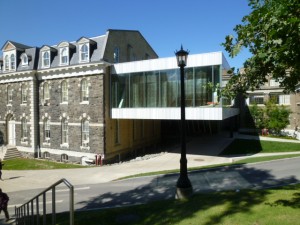 Milstein Hall, an addition to the College of Architecture, Art and Planning at Cornell designed by Rem Koolhaas, received an AIA Honor Award in 2013. The jury commented that “The dramatic insertion of the new program in relationship to the existing buildings and site creates exciting new conditions while posing a series of creative opportunities for future uses and artistic additions by the college.” I was in the building earlier this week to give a lecture, and I must admit that I was puzzled by the award. The boxy wing makes an awkward appendage to the old building. The Crown Hall-like studio seemed adequate if a little impersonal, although it raises the question—as Mies’s building does—of why a studio requires a column-free space, with the attendant structural complexity and cost. At $1,100 psf, Milstein is an expensive building, though the money does not appear to have been spent on details and materials, which are spartan. It was spent on a dramatic (the jury was right there) 48-foot cantilever that projects the building over the street—but to what end? Inside, there is a crit area in a cavelike space that, like most caves, has spectacular echoes. As for the auditorium, it was not a pleasant room in which to lecture. The seats are steeply raked, which is normally effective, but are separated from the podium by a large flat area that acts as a sort of no-man’s land, since no student will sit there. Apparently the flat floor conceals a conference room (for the university board) that emerges from beneath at the push of a button. It’s hard to imagine that this was really the most convenient solution. Any more than designing an auditorium that is surrounded by glass walls. But then so much about this idiosyncratic building defies logic. “Typically, after Koolhaas finishes his design, a sort of clean-up crew comes in and sorts out the problems,” I was told. Maybe they should have gotten the award.
Milstein Hall, an addition to the College of Architecture, Art and Planning at Cornell designed by Rem Koolhaas, received an AIA Honor Award in 2013. The jury commented that “The dramatic insertion of the new program in relationship to the existing buildings and site creates exciting new conditions while posing a series of creative opportunities for future uses and artistic additions by the college.” I was in the building earlier this week to give a lecture, and I must admit that I was puzzled by the award. The boxy wing makes an awkward appendage to the old building. The Crown Hall-like studio seemed adequate if a little impersonal, although it raises the question—as Mies’s building does—of why a studio requires a column-free space, with the attendant structural complexity and cost. At $1,100 psf, Milstein is an expensive building, though the money does not appear to have been spent on details and materials, which are spartan. It was spent on a dramatic (the jury was right there) 48-foot cantilever that projects the building over the street—but to what end? Inside, there is a crit area in a cavelike space that, like most caves, has spectacular echoes. As for the auditorium, it was not a pleasant room in which to lecture. The seats are steeply raked, which is normally effective, but are separated from the podium by a large flat area that acts as a sort of no-man’s land, since no student will sit there. Apparently the flat floor conceals a conference room (for the university board) that emerges from beneath at the push of a button. It’s hard to imagine that this was really the most convenient solution. Any more than designing an auditorium that is surrounded by glass walls. But then so much about this idiosyncratic building defies logic. “Typically, after Koolhaas finishes his design, a sort of clean-up crew comes in and sorts out the problems,” I was told. Maybe they should have gotten the award.
On Culture and Architecture

So much of the “starchitect” portfolio is visually impressive, but leaves a body perplexed and confounded.
I recently had the opportunity to visit Anthony Predock’s Canadian Museum for Human Rights in Winnipeg, Canada. It is an awe-inspiring structure to be sure. But walking through it, it feels like the building is shouting in an unknown language. The vocabulary might be known only to Predock himself. Price tag: $300+ million
When I got home, I saw that my son had borrowed from the library a selection of books on small, laneway houses. They almost all used a very familiar vernacular, which I could easily understand even in their under-sized whisper. Price tag: $5-30K
It made me wonder which design was most concerned with human rights.
Thank you for your blog, and for explaining the language of architecture to the lay public like myself.